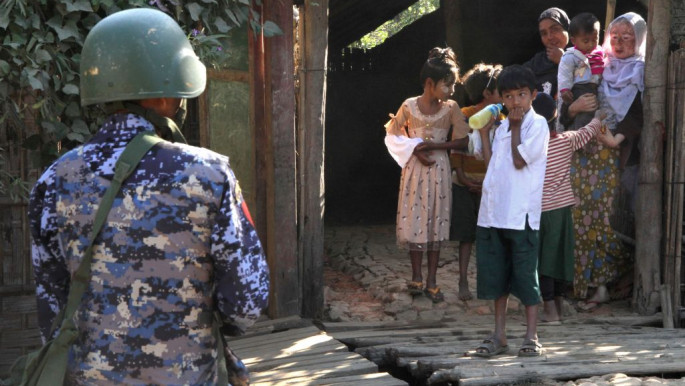
Renewed campaign to wipe out surviving Rohingya will be the most savage yet
In a video sent to me by a Rohingya source in neighbouring Bangladesh, mangled and charcoaled bodies are identifiable as they lay strewn among smouldering thatched huts, which were their sanctuary and home only a few minutes earlier.
Eighteen months have now passed since Myanmar's genocidal intent forced 800,000 Rohingya to flee their homes for sanctuary on the border of Bangladesh, but there's growing evidence the military junta in Yangon, which poses as a quasi-democracy, is using its ground offensive against the separatist Arakan Army as a pretext to "clean out," once and for all, the 500,000 Rohingya who remain in the country.
There's also every reason to believe that this next wave of violence against the Muslim minority promises to the most vicious to date, as many are also being caught in the cross fire between Myanmar soldiers and Buddhist Arakan guerillas, with more than 1,200 Rohingya forced to flee their villages during a single eight-hour period of fighting earlier this month.
These suddenly internally displaced people (IDP) join the other 50,000 to 100,000, equating to upwards of one-quarter of the remaining Rohingya in Myanmar, who have fled their homes and villages within the past two weeks.
International aid workers are warning the next phase of this ongoing humanitarian crisis is about to crash onto the shores of neighbouring Asian countries, a warning underscored by the fact that boats carrying up to 200 Rohingya refugees have landed on Malaysian shorts in the past week alone.
 |
The international community sits idly on its hands, seemingly content with the status quo |  |
"Since there was no one to greet them, they made their way in separate groups to the nearby villages, covered in mud," explained one Reuters report.
These are the lucky ones, but hundreds of thousands of Rohingya await a fate far less fortunate, especially given Aung San Suu Kyi is stonewalling international aid. This amounts to another unconscionable crime, given 25 percent of IDPs in Rakhine state are under eight years of age, alongside another 28 percent who are under age 14.
Read more: Rohingya arrive in Malaysia, more believed at sea
Without access to medicine and foods, and surrounded by fighting on all sides, Rohingya survivors of the 2017-18 genocide are selling off their properties and belongings human traffickers to get them either across the border into Bangladesh, or into boats like those already heading to Malaysia.
 |
|
| A Myanmar border guard stands near a Rohingya Muslim family in the Buthidaung townships of Rakhine state [Getty] |
If Myanmar's concerted effort to ethnically cleanse the Rohingya in the 18-month period spanning 2017-2018 was brutal, then it's likely the current effort to oust them from the country in 2019 will be the most savage yet.
To put this forecast into some context, consider that 24,000 Rohingya Muslims were killed by the Myanmar military in the August 2017 to November 2018 period, according the Ontario International Development Agency (OIDA).
Consider also, that 114,000 others were beaten, alongside another 18,000 women and girls who were raped by Myanmar soldiers, according to another report entitled, "Forced Migration of Rohingya: The Untold Experience".
 |
The Arakan Army has planted landmines around Rohingya villages in northern Rathedaung in order to prevent Myanmar soldiers from entering |  |
The Arakan Army has planted landmines around Rohingya villages in northern Rathedaung in order to prevent Myanmar soldiers from entering and encamping the villages belonging to those aligned with the Arakanese separatist group.
"This worries the Rohingya villagers of accidentally getting hit by the landmines and becoming victims in the potential clashes between the Myanmar military and Rakhine rebels in nearby villages," says Yan Naing, a Rohingya blogger and activist.
These atrocities and human rights violations take place as the international community sits idly on its hands, seemingly content with the status quo, and happy for Bangladesh, which has provided temporary refuge to 800,000 Rohingya, to deal with this humanitarian crisis on its own, despite the government in Dhaka's growing frustration.
The Bangladesh-Myanmar repatriation deal has long stalled, mostly because Rohingya refugees refused to be returned without a security guarantee, to the hands of those who had murdered their families. Renewed violence against the Rohingya, including last week's gun ship attack by the Myanmar military vindicates these fears.
 |
24,000 Rohingya Muslims were killed by the Myanmar military from August 2017 to November 2018 |  |
Last week, however, the Association of Southeast Asian Nations (ASEAN) announced it wishes to play a "leading role" in the repatriation of Rohingya refugees by establishing "safe zones" or rather creating conditions in which 800,000 Rohingya will feel safe to return.
This, however, will take nothing shy of something akin to a UN peacekeeping force, and enough international pressure to force Myanmar into accepting a resolution that grants 1.3 million Rohingya full citizenship rights, and an end to the apartheid conditions they've been subjected to for the past six decades.
Certainly, realities on the ground warrant and justify immediate and collective action, because absent renewed interest and intent from the international community, Myanmar will feel emboldened to fulfil what it has long wanted to do: Eradicate Rohingya Muslims now and forever.
CJ Werleman is the author of 'Crucifying America', 'God Hates You, Hate Him Back' and 'Koran Curious', and is the host of Foreign Object.
Follow him on Twitter: @cjwerleman
Opinions expressed in this article remain those of the author and do not necessarily represent those of The New Arab, its editorial board or staff.





 Follow the Middle East's top stories in English at The New Arab on Google News
Follow the Middle East's top stories in English at The New Arab on Google News


